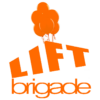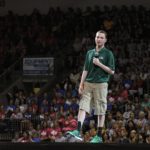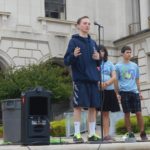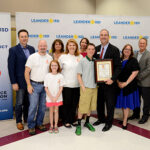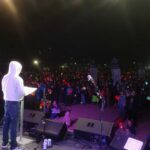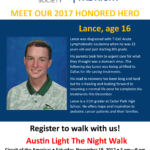
We exist because a young teen cancer patient, Lance White, wanted to help other kids at his clinic going thru what he was going thru. Beyond our programs and efforts, Lift Brigade works to support Lance’s mission by raising awareness and advocating #forthekids.
Positive Healthcare Experiences
One advocacy area we support focuses on the broader perspective of pediatric (children) patients dealing with cancer and other life-threatening diagnoses and the often difficult healthcare experience they face. Every effort needs to be made to ensure that this experience is as positive as possible. This includes family members as well.
In addition to program efforts that support our advocacy positions, Lift Brigade board member (and Lance’s mom) Priscilla White sits on the Dell Children’s Medical Center (DCMC) Patient Family Advisory Council.
Secondary Iron Overload
A common side effect of chemotherapy treatments is low blood counts. If your child is receiving multiple red blood cell (RBC) transfusions during cancer treatment, advocate for monitoring and understanding of the impact of these transfusions on their body.
With each RBC transfusion, your body receives more iron. As red cells break down over time, the iron is released. Your body has no natural way to rid itself of excess iron. Extra iron that is not immediately needed to make new blood cells is normally stored in the liver, spleen, and bone marrow.
Lance’s Story
In September of 2020, five (5) full years after having his last RBC transfusion, Lance was found to have to have roughly 20 times the amount of iron stored in his liver than he was supposed to have.
Link to full post re. Secondary Iron Overload
Childhood Cancer Awareness
Childhood cancer is a rare disease, with about 15,000 cases diagnosed annually in the United States in individuals younger than 20 years. The U.S. Rare Diseases Act of 2002 defines a rare disease as one that affects populations smaller than 200,000 persons. Therefore, all pediatric cancers are considered rare.
Despite its designation as a rare disease, more children in the U.S. die of childhood cancer than ALL other diseases combined.
As a family we have been greatly impacted by Lance’s cancer fight. Our hearts have broken for neighbors and patients we had come to know. We have also celebrated with many families on their child’s path to survivorship.
However, while exciting advancements are starting to come to the market, reality is…
that in the last 20 years, only four new drugs have been approved that were specifically developed to treat children with cancer. Even the new (CAR) T-Cell Therapy is limited in scope as tool for second or later relapses in most all cases at this time.
Doctors and researchers don’t know what causes most childhood cancers.
Brain cancer is now the deadliest childhood cancer in the US, now ahead of leukemia, a result of improved leukemia treatment and a frustrating lack of progress on brain cancer.
60% of children who survive suffer devastating late effects such as secondary cancers, muscular difficulties and infertility.
RACE for Children Act (Research to Accelerate Cures and Equity for Children Act)
NOTE: Click here for original story on KXAN
Lance, who spent 3 and 1/2 years undergoing chemotherapy treatment, ended treatment diagnosed with the following:
Peripheral neuropathy, a result of damage to the nerves outside of the brain and spinal cord (peripheral nerves), often causes weakness, numbness and pain, usually in your hands and feet. This was primarily caused by the chemotherapy drug – Vincristine – and lessor to certain antibiotics like Cipro that Lance took on numerous occasions to treat infections while in the hospital.
Osteoporosis, caused by the numerous chemotherapy drugs and steroids Lance took throughout his treatment. The report actually compared his bones to that of a 60-year old female. Note: because of Lance’s young age there is hope that his bone density will improve. That being said, Lance fractured both of his heels after treatment.
Hopefully you can see why awareness is so necessary in the battle against childhood cancer. To this end, Lance and his family have spoken at numerous events and fundraiser sharing their story with the hope of educating the masses, raising awareness and fundraising support. We have also worked with local city and school district officials to raise awareness on childhood cancer and the impact upon the family and community.
Childhood Cancer Research
Two organizations that we have spent time supporting through various events are the Leukemia and Lymphoma Society (LLS) and St. Baldrick’s.
Leukemia and Lymphoma Society (LLS)
In early 2014, just months into Lance’s cancer battle with Leukemia we participated in our 1st Light the Night Walk and generated $1,550 for LLS. In 2017 Lance was a Light the Night Walk Honored Hero and spoke in front of over 7,000 people about his journey. LLS has been a major reason in the survivorship improvement of childhood and adult blood cancers.
St. Baldrick’s
St. Baldrick’s raises money for childhood cancer research. Medical teams apply for St. Baldrick’s grants each year. To date we have supported numerous St. Baldrick’s events that have, all combined, raised over $500,000 for childhood cancer research. We also support many families that raise targeted (e.g. brain cancer research) funds in memory of their children.
Community Awareness

Lance and Lift Brigade worked Cedar Park city leadership to formally recognize September as Childhood Cancer Awareness Month. City of Cedar Park Mayor, Matt Powell, and City Manager, Brenda Eivens, presented the Proclamation at our golf tournament.
